The MSI MEG X570 Godlike Motherboard Review: Thor's Flagship
by Gavin Bonshor on August 28, 2019 12:00 PM EST- Posted in
- Motherboards
- AMD
- MSI
- 10G Ethernet
- Ryzen
- PCIe 4.0
- Ryzen 3000
- X570
- X570 Godlike
- MEG
CPU Performance, Short Form
For our motherboard reviews, we use our short form testing method. These tests usually focus on if a motherboard is using MultiCore Turbo (the feature used to have maximum turbo on at all times, giving a frequency advantage), or if there are slight gains to be had from tweaking the firmware. We put the memory settings at the CPU manufacturers suggested frequency, making it very easy to see which motherboards have MCT enabled by default.
For X570 we are running using Windows 10 64-bit with the 1903 update as per our Ryzen 3000 CPU review.
Rendering - Blender 2.7b: 3D Creation Suite - link
A high profile rendering tool, Blender is open-source allowing for massive amounts of configurability, and is used by a number of high-profile animation studios worldwide. The organization recently released a Blender benchmark package, a couple of weeks after we had narrowed our Blender test for our new suite, however their test can take over an hour. For our results, we run one of the sub-tests in that suite through the command line - a standard ‘bmw27’ scene in CPU only mode, and measure the time to complete the render.
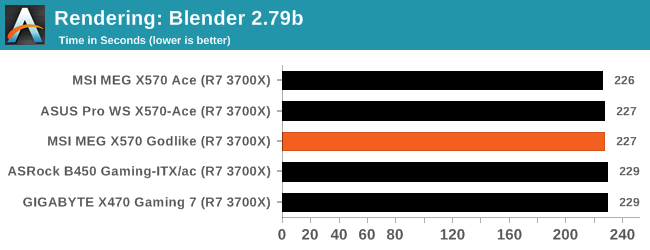
Streaming and Archival Video Transcoding - Handbrake 1.1.0
A popular open source tool, Handbrake is the anything-to-anything video conversion software that a number of people use as a reference point. The danger is always on version numbers and optimization, for example the latest versions of the software can take advantage of AVX-512 and OpenCL to accelerate certain types of transcoding and algorithms. The version we use here is a pure CPU play, with common transcoding variations.
We have split Handbrake up into several tests, using a Logitech C920 1080p60 native webcam recording (essentially a streamer recording), and convert them into two types of streaming formats and one for archival. The output settings used are:
- 720p60 at 6000 kbps constant bit rate, fast setting, high profile
- 1080p60 at 3500 kbps constant bit rate, faster setting, main profile
- 1080p60 HEVC at 3500 kbps variable bit rate, fast setting, main profile
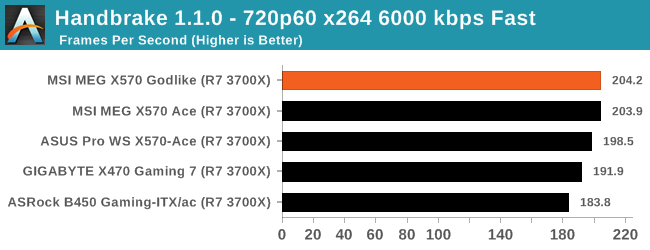
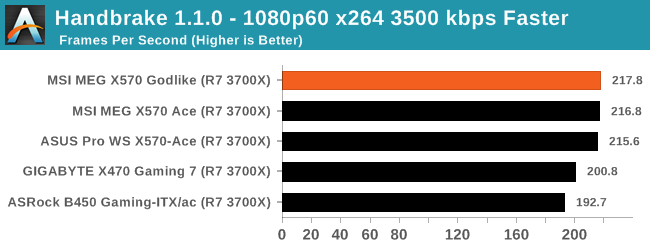
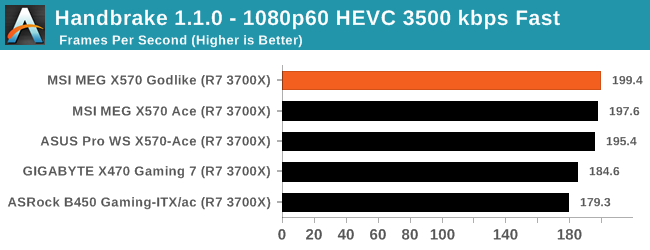
Rendering – POV-Ray 3.7.1: Ray Tracing - link
The Persistence of Vision Ray Tracer, or POV-Ray, is a freeware package for as the name suggests, ray tracing. It is a pure renderer, rather than modeling software, but the latest beta version contains a handy benchmark for stressing all processing threads on a platform. We have been using this test in motherboard reviews to test memory stability at various CPU speeds to good effect – if it passes the test, the IMC in the CPU is stable for a given CPU speed. As a CPU test, it runs for approximately 1-2 minutes on high-end platforms.
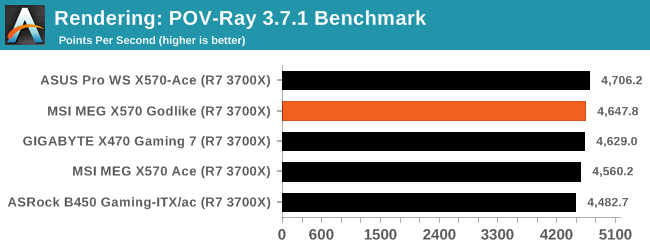
Compression – WinRAR 5.60b3: link
Our WinRAR test from 2013 is updated to the latest version of WinRAR at the start of 2014. We compress a set of 2867 files across 320 folders totaling 1.52 GB in size – 95% of these files are small typical website files, and the rest (90% of the size) are small 30-second 720p videos.

Synthetic – 7-Zip v1805: link
Out of our compression/decompression tool tests, 7-zip is the most requested and comes with a built-in benchmark. For our test suite, we’ve pulled the latest version of the software and we run the benchmark from the command line, reporting the compression, decompression, and a combined score.
It is noted in this benchmark that the latest multi-die processors have very bi-modal performance between compression and decompression, performing well in one and badly in the other. There are also discussions around how the Windows Scheduler is implementing every thread. As we get more results, it will be interesting to see how this plays out.
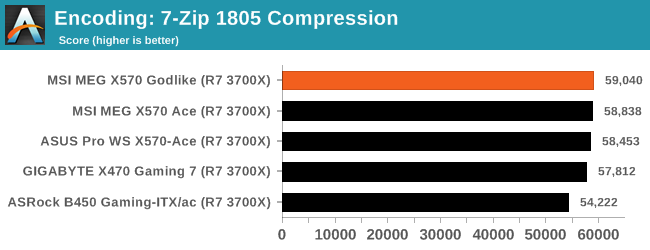
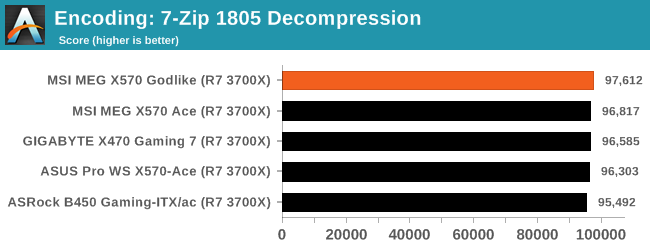
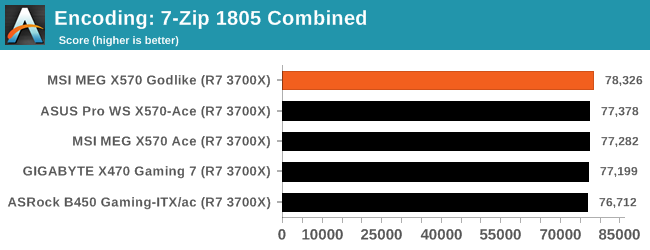
Point Calculations – 3D Movement Algorithm Test: link
3DPM is a self-penned benchmark, taking basic 3D movement algorithms used in Brownian Motion simulations and testing them for speed. High floating point performance, MHz, and IPC win in the single thread version, whereas the multithread version has to handle the threads and loves more cores. For a brief explanation of the platform agnostic coding behind this benchmark, see my forum post here.
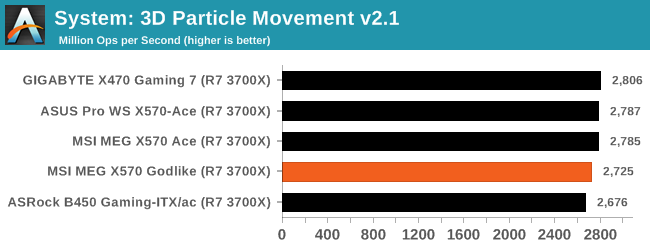
Neuron Simulation - DigiCortex v1.20: link
The newest benchmark in our suite is DigiCortex, a simulation of biologically plausible neural network circuits, and simulates activity of neurons and synapses. DigiCortex relies heavily on a mix of DRAM speed and computational throughput, indicating that systems which apply memory profiles properly should benefit and those that play fast and loose with overclocking settings might get some extra speed up. Results are taken during the steady-state period in a 32k neuron simulation and represented as a function of the ability to simulate in real time (1.000x equals real-time).
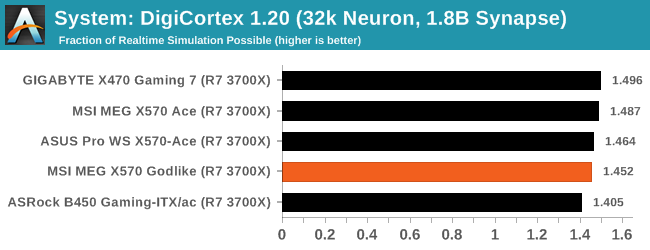










116 Comments
View All Comments
imaheadcase - Wednesday, August 28, 2019 - link
I mean it is cool and nice features, but $700 for a mobo when its the core component of a system..and also the one that is easiest to get outdated faster is kinda silly. I suppose the argument is that if buying it not really going to care about costs anyways. hehegoatfajitas - Wednesday, August 28, 2019 - link
Yeah, especially when there are alot of motherboards that are very nearly as good for a lot less. These $700 models probably overclock like crazy, but it's just not as needed as it was 10+ years ago. CPU is almost never the bottleneck anymore so overclocking it is kinda moot.Smell This - Wednesday, August 28, 2019 - link
Odd in that MSI CEO Charles Chiang dumped-on AMD 8 months ago --- then proceeds to market $700+ SP3 motherboards ...
https://www.tomshardware.com/news/msi-ceo-intervie...
Samus - Wednesday, August 28, 2019 - link
I remember that article and was actually thinking the same thing. What honor is there in stabbing someone in the back then patting them on the back 8 months later?Peter2k - Thursday, August 29, 2019 - link
Because Gigabyte and Asus have 700$ boards with they're gaming brands?WaltC - Thursday, August 29, 2019 - link
Yes, and funny thing is....look what they're doing to retrofit their cheap x370/x470 motherboards to Zen 2...;) Sort of puts him in the "I don't know what I'm saying sometimes" category, eh? Too funny!ballsystemlord - Thursday, August 29, 2019 - link
I just read the article and can't find a single stab. He said only that AMD did not have good support a few years ago. Such a statement is either fact or fiction, and if fact, then totally benign.Point out to me the correct position in the article if I'm wrong.
Smell This - Tuesday, September 3, 2019 - link
MSI and **Chuckles** abandoned AMD -- not the other way around. Fair-Weather Chuck took his payola from Chipzillah and scooted, leaving AM2/AM3/AM4 in the wind (until he saw the $$$).It's been downhill for MSI since the 790FX K9A2 Platinum ...
Sweetbabyjays - Wednesday, August 28, 2019 - link
"overclock like crazy" I know right! Going from 4.0 to 4.2 GHz is pretty crazy. Totally worth the extra $450 you're paying.Seriously for this price you're better off getting a 9900k and a high end z390 board if you're fine with 8c/16t. Overclock to 4.8GHz on all cores and call it a day for same price as just the x570 motherboard. A 9900k at 4.8GHz is better than any 8c/16t AMD CPU in literally every single scenario.
Tunnah - Wednesday, August 28, 2019 - link
So you'd settle for a more power hungry CPU, with a motherboard with less future proofing, less expansion, and less features, just for the few percent difference in performance ?